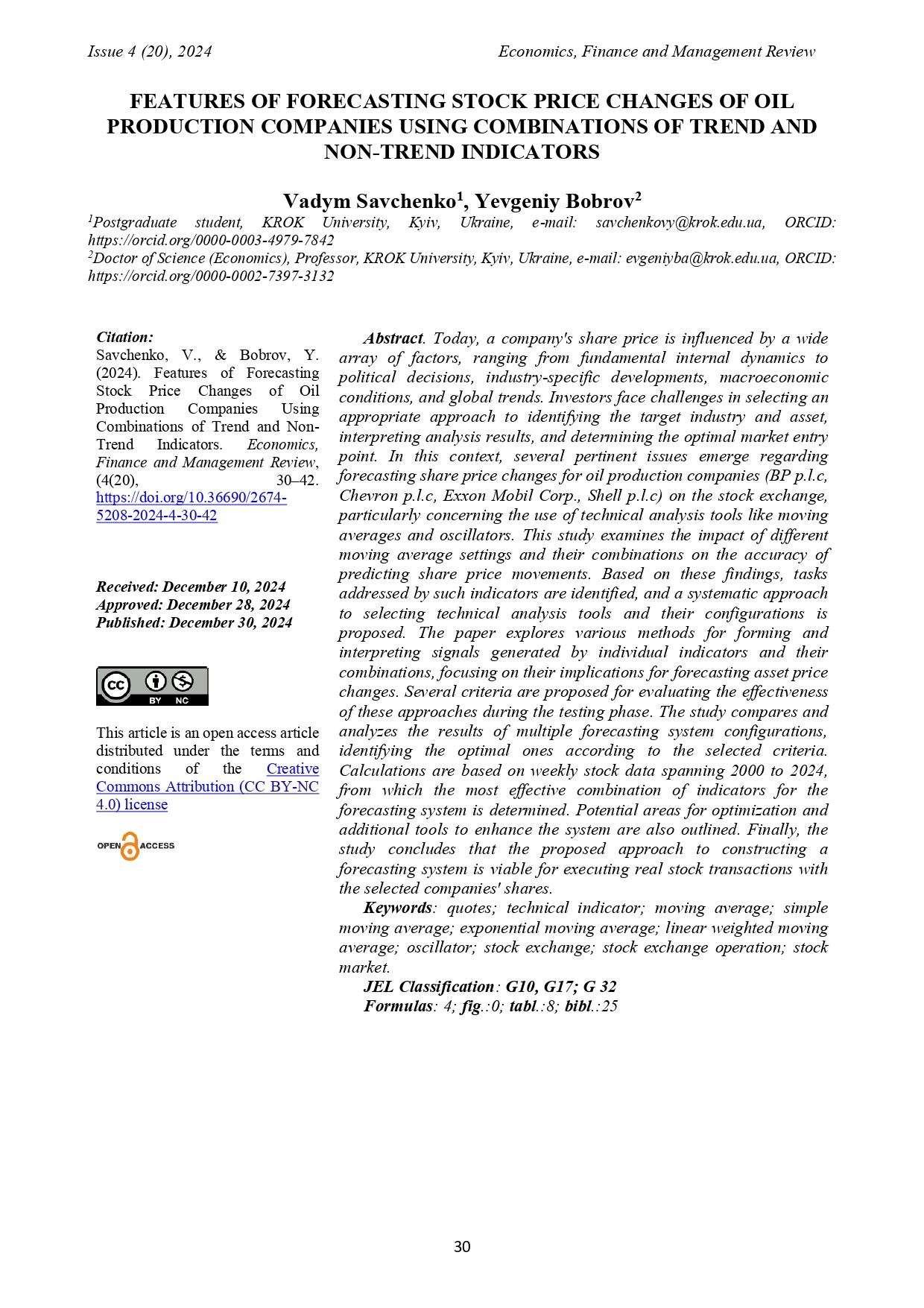FEATURES OF FORECASTING STOCK PRICE CHANGES OF OIL PRODUCTION COMPANIES USING COMBINATIONS OF TREND AND NON-TREND INDICATORS
DOI:
https://doi.org/10.36690/2674-5208-2024-4-30-42Keywords:
quotes, technical indicator, moving average, simple moving average, exponential moving average, linear weighted moving average, oscillator, stock exchange, stock exchange operation, stock market, trading systemAbstract
Today, a company's share price is influenced by a wide array of factors, ranging from fundamental internal dynamics to political decisions, industry-specific developments, macroeconomic conditions, and global trends. Investors face challenges in selecting an appropriate approach to identifying the target industry and asset, interpreting analysis results, and determining the optimal market entry point. In this context, several pertinent issues emerge regarding forecasting share price changes for oil production companies (BP p.l.c, Chevron p.l.c, Exxon Mobil Corp., Shell p.l.c) on the stock exchange, particularly concerning the use of technical analysis tools like moving averages and oscillators. This study examines the impact of different moving average settings and their combinations on the accuracy of predicting share price movements. Based on these findings, tasks addressed by such indicators are identified, and a systematic approach to selecting technical analysis tools and their configurations is proposed. The paper explores various methods for forming and interpreting signals generated by individual indicators and their combinations, focusing on their implications for forecasting asset price changes. Several criteria are proposed for evaluating the effectiveness of these approaches during the testing phase. The study compares and analyzes the results of multiple forecasting system configurations, identifying the optimal ones according to the selected criteria. Calculations are based on weekly stock data spanning 2000 to 2024, from which the most effective combination of indicators for the forecasting system is determined. Potential areas for optimization and additional tools to enhance the system are also outlined. Finally, the study concludes that the proposed approach to constructing a forecasting system is viable for executing real stock transactions with the selected companies' shares.
Downloads
References
Heather Cullen. (2024). In The Money: Bull Market Strategy. Wrozlaw, Amazon fulfilment.
George Soros, Paul A. Volcker. (2003). The Alchemy of Finance. John Wiley & Sons Inc.
Bobrov, Y (2013). Analysis of the activities of uncontrolled investment schemes. Finances of Ukraine. 4. 98-105. URL: http://nbuv.gov.ua/UJRN/Fu_2013_4_10 (09.12.2024)
Chuanjun Zhao, Meiling Wu, Jingfeng Liu, Zening Duan, Jie li, Lihua Shen, Xuekui Shangguan, Donghang Liu, Yanjie Wang. (2023). Progress and prospects of data-driven stock price forecasting research. International Journal of Cognitive Computing in Engineering, 4, 100-108. https://doi.org/10.1016/j.ijcce.2023.03.001.
A. Fazeli and S. Houghten, "Deep Learning for the Prediction of Stock Market Trends," 2019 IEEE International Conference on Big Data (Big Data), Los Angeles, CA, USA, 2019, pp. 5513-5521, https://doi.org/10.1109/BigData47090.2019.9005523
Chen, M., Gong, Y., & Ming-Tai Wu, J. (2021). Impact of Technical Indicators and Leading Indicators on Stock Trends on the Internet of Things. Wireless Communications and Mobile Computing, 2022(1), 9916310. https://doi.org/10.1155/2022/9916310
Bang, J., & Ryu, D. (2023). CNN-based stock price forecasting by stock chart images. Romanian Journal of Economic Forecasting, 26(3), 120-128. URL: https://ipe.ro/new/rjef/rjef3_2023/rjef3_2023p120-128.pdf (08.12.2024).
Ali H. Dhafer, Fauzias Mat Nor, Gamal Alkawsi, Abdulaleem Z. Al-Othmani, Nuradli Ridzwan Shah, Huda M. Alshanbari, Khairil Faizal Bin Khairi, Yahia Baashar (2022). Empirical analysis for stock price prediction using NARX model with exogenous technical indicators. Computational intelligence and neuroscience, 2022(1), 9208640. https://doi.org/10.1155/2022/9208640
Hani'ah, M., Abdullah, M. Z., Sabilla, W. I., Akbar, S., & Shafara, D. R. (2023). Google Trends and Technical Indicator based Machine Learning for Stock Market Prediction. MATRIK: Jurnal Manajemen, Teknik Informatika dan Rekayasa Komputer, 22(2), 271-284. https://doi.org/10.30812/matrik.v22i2.2287
Zhang, D., & Tang, P. (2023). Forecasting European Union allowances futures: The role of technical indicators. Energy, 270, 126916. https://doi.org/10.1016/j.energy.2023.126916
Fu, K., & Zhang, Y. (2024). Incorporating Multi-Source Market Sentiment and Price Data for Stock Price Prediction. Mathematics, 12(10), 1572. https://doi.org/10.3390/math12101572
Saud, A. S., & Shakya, S. (2024). Technical indicator empowered intelligent strategies to predict stock trading signals. Journal of Open Innovation: Technology, Market, and Complexity, 10(4), 100398. https://doi.org/10.1016/j.joitmc.2024.100398
Wang, H. C., Hsiao, W. C., & Liou, R. S. (2024). Integrating technical indicators, chip factors and stock news for enhanced stock price predictions: A multi-kernel approach. Asia Pacific Management Review, 29(3), 292-305. https://doi.org/10.1016/j.apmrv.2023.10.001
Chart School. Moving averages: simple and exponential. Stock Charts. URL: https://school.stockcharts.com/doku.php (03.12.2024).
Aronson, D. (2011). Evidence-based technical analysis: applying the scientifi c method and statistical inference to trading signals. John Wiley & Sons.
Joseph, V., Vakayil, A. (2021). SPlit: An Optimal Method for Data Splitting. Technometrics, 64(2), 166-176. https://doi.org/10.1080/00401706.2021.1921037
Savchenko, V., Bobrov, Y. (2024). Features of forecasting stock quote changes using moving averages and oscillators: case study of an oil production company. Economics of Ukraine. 67. 11 (756). 74-98. https://doi.org/10.15407/economyukr.2024.11.074
Murphy, J. (1999). Technical analysis of financial markets: A comprehensive guide to trading methods and applications. New York, New York Institute of Finance.
Savchenko, V. (2023). Сomparison of systems of forecasting the direction of changes in the exchange rate of a financial instrument using simple,exponential and linear weighted moving averages. Scientific notes of “KROK” University № 3(71). 19-30. https://doi.org/10.31732/2663-2209-2022-71-19-30
Largest oil and gas companies by market cap. URL: https://companiesmarketcap.com/oil-gas/largest-oil-and-gas-companies-by-market-cap (04.12.2024).
BP. p.lc. Common Stock (BP). Nasdaq. URL: https://www.nasdaq.com/market-activity/stocks/bp (04.12.2024).
Chevron Corporation Common Stock (CVX). Nasdaq. URL: https://www.nasdaq.com/market-activity/stocks/cvx (04.12.2024).
Exxon Mobil Corporation Common Stock (XOM). Nasdaq. URL: https://www.nasdaq.com/market-activity/stocks/xom (03.12.2024).
Marathon Petroleum Corporation Common Stock (MPC). Nasdaq. URL: https://www.nasdaq.com/market-activity/stocks/mpc (04.12.2024).
Shell PLC Stock (SHEL). London Stock Exchange. URL: https://www.londonstockexchange.com/stock/SHEL/shell-plc/company-page (04.12.2024).

Downloads
Published
How to Cite
Issue
Section
License

This work is licensed under a Creative Commons Attribution-NonCommercial 4.0 International License.








